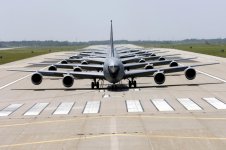It is kinda old, but I guarantee the C-17 will be around for a looooooong time. That's probably the best candidate airplane in our current inventory to eventually outlive the B-52. If we don't wear them all out prematurely in South West Asia.
Of the engines mentioned in your link, the CFM56, the CF34, and the Royal-Royce RB.211; the PW2000 is the youngest. Though the GE's CF34 is from that same early '80's era.
The previous link mentions the Pratt & Whitney PW1135. That is a new engine. Base on a design first run in 2008. Maybe that will be the hot ticket.
Whatever is on the new tanker won't work. That's a two engine airplane, so they'll be way to big for the Buff.
My money is on the C-130. First flight was 1954 (just a few years after the B-52 first flight) and 60 years later we are STILL making them! The last B-52 rolled off the line in 1962.
It depends on how you look at it. In "service" there are still plenty of DC-3s flying around delivering cargo and passengers, and there are probably still more than a few military operators in third world countries. The DC-3 makes the C-130 look young.
With regard to the C-130 however, eventually it may out last the DC-3.
The center wing box has a life limit of 60,000 flight hours and a corrosion limit of 40,000 flight hours. The former is dependent on a mission severity factor multiplied by the flight hours and the latter is dependent on where it's located, operated and engineering opinion based on inspections.
Ui USAF service, we're just now retiring the E model based HC-130Ps and they are for the most part still under those limits.
The USAF is talking about a C-"X" to replace both he C-130 in the tactical airlift role and the C-17 in the strategic airlift role, but it won't fly until 2024 at the earliest and would probably not be in production until 2030. That would leave the C-130 in service from 1957 (actually December 1956) until 2030, a 73 year span, and that's only if the C-X flies and the C-130s ar al phased out in 2030. If the C-"X" does not materialize, the C-130 won't be going anywhere soon, and even if it does materialize, the C-130 will probably still hang around in service for another decade until 2040 or so. Either way, the C-130 won't be going anywhere soon in US service and we can expect a 75-80 year service life.
US service is also only a small piece of the puzzle as well, given that it is in service with over 70 countries as well as civilian operators. Total service life will probably top 100 years, if it follows the same post USAF service trajectory of the DC-3.
Where the B-52 is king is in the service life of the individual airframes. As noted above, the last H model rolled out the door at Boeing in 1962. That makes the youngest H model 53 years old. There are USAF pilots flying the same airframes their grandfathers flew.
That's a testament to the durability and adaptability of the B-52 airframe , as well as to the short sighted nature of USAF procurement.
The old joke is that the crews that retire the last B-1 and B-2 to Davis-Monthan will be picked up by a B-52. That's not much of a stretch as the B-52s today are not averaging anywhere near the flight hours they averaged during the airborne alert years, so they have a lot of life left in them at current utilization rates.

